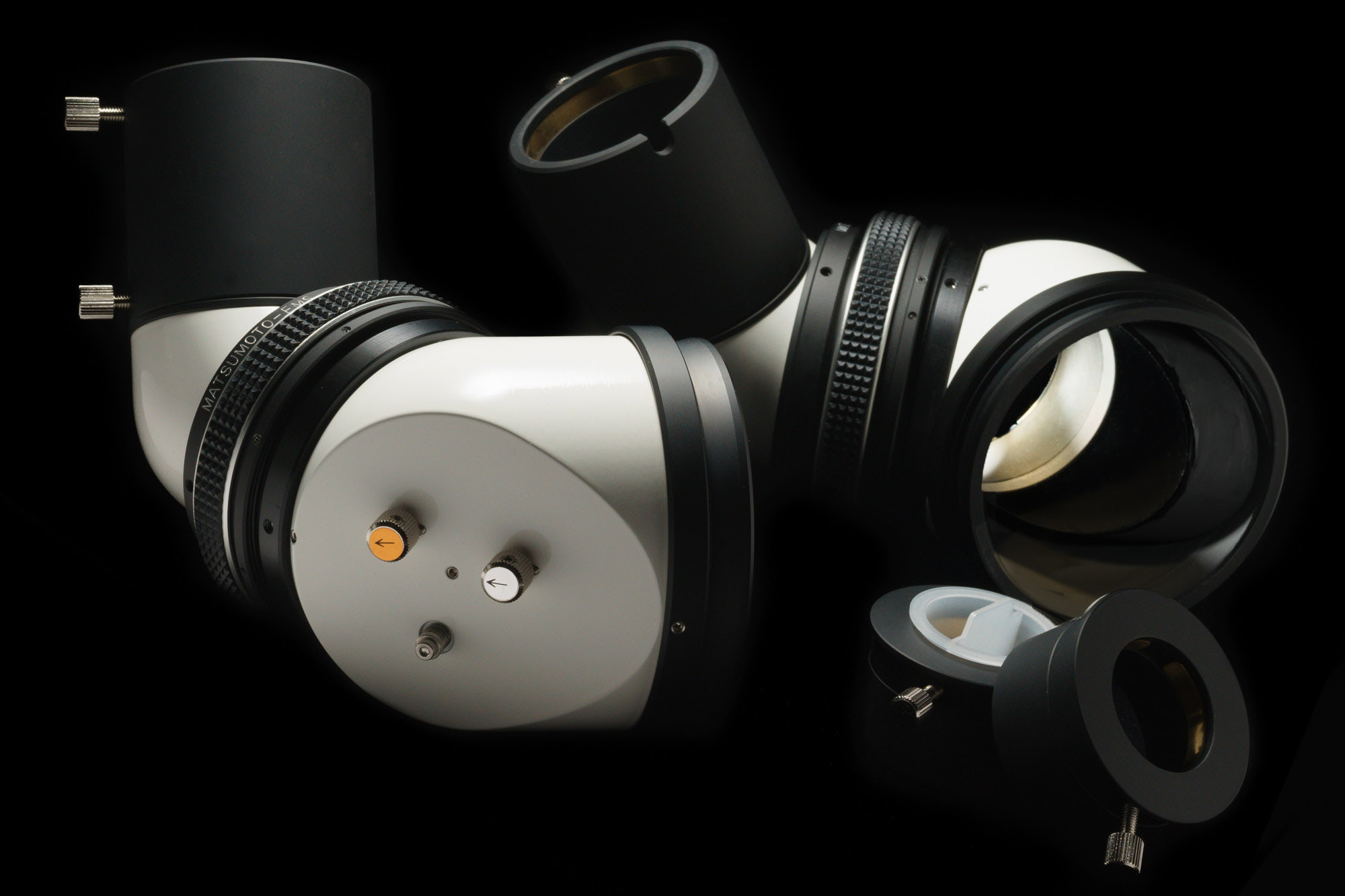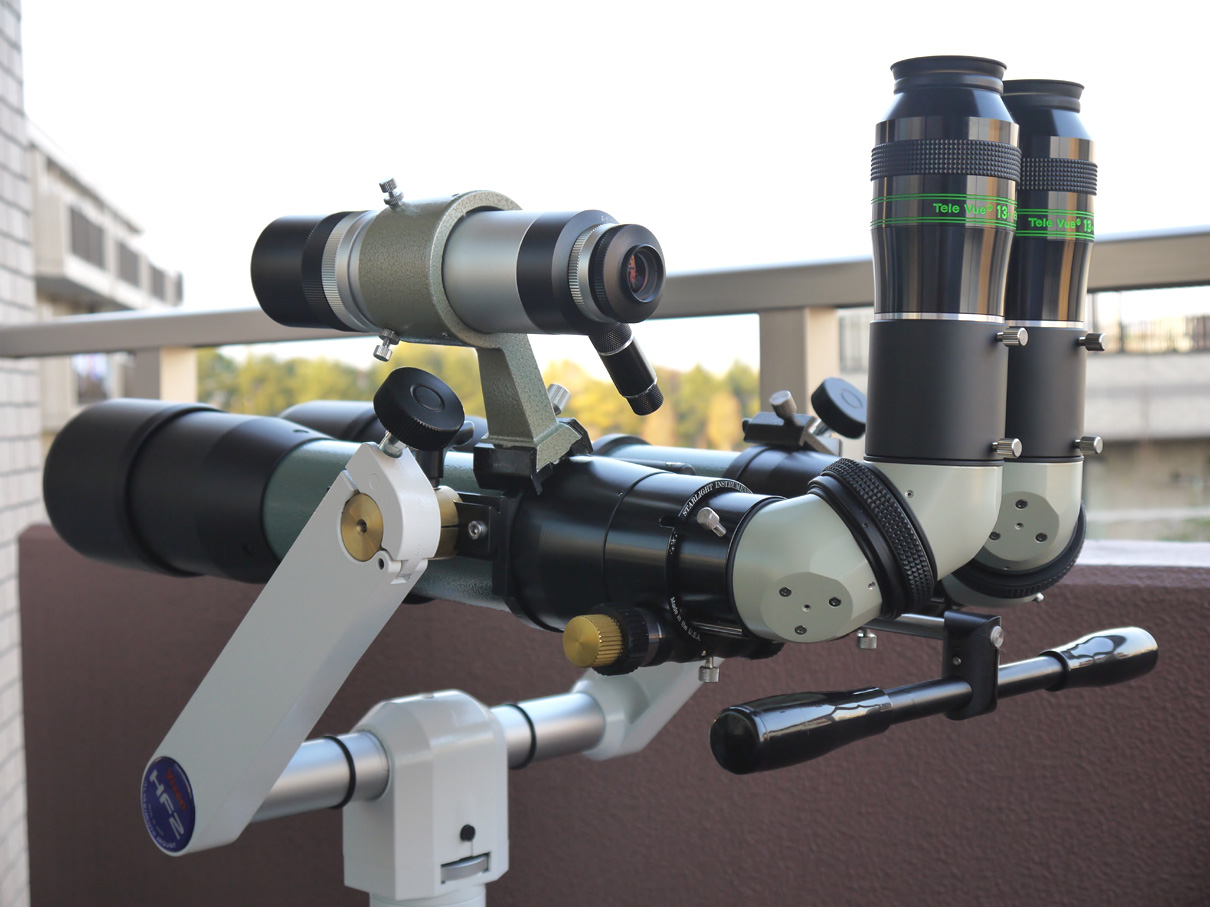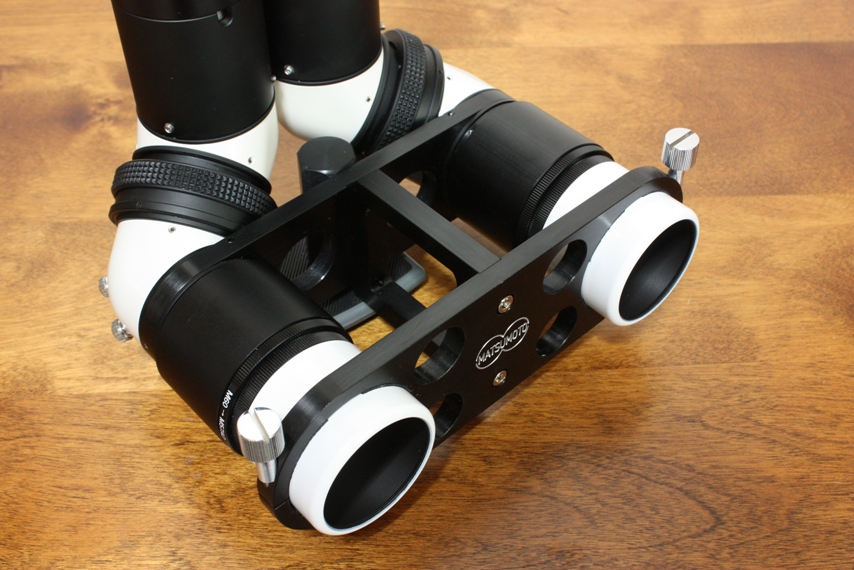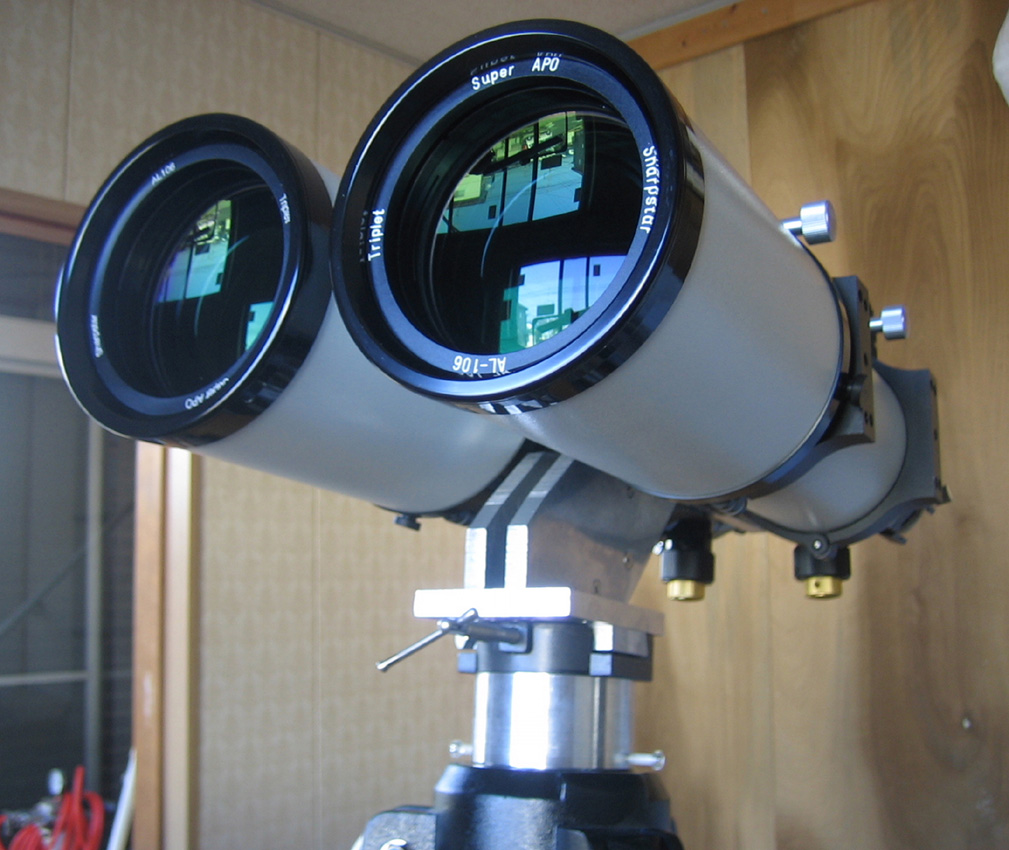【BORG50-BINOレポート】
【導入の経緯】
EMS-BINOに魅せられて、3台のBINOを使用してきました。このうち1台(Pront-BINO)のEMSを銀ミラーに換装しましたが、 その際余剰となったアルミミラーはEMS-Lとして再度組み立てて頂きました。
このEMS-Lの用途として「手持ちのファインダー対物レンズを流用した2インチアイピース対応ファインダー」を考え 松本さんに相談しましたが、対物レンズのF値が3強程度と短く、脚部・光軸調整機構が複雑になりそうで断念しました。 (BINO Progress Report 製作状況速報の2011,7月13日-2) そこで以前から興味のあった横浜のKさんのBROG50-BINOを参考に正立対空双眼鏡として組上げることにしました。
【写真1】右側がテレビューPront-BINO(口径70mm)、中央がBORG50-BINO、左側は7倍50mm IF式双眼鏡(タカハシ アストロノーマー7×50)です。 並べると、BORG50-BINOはまるでEMSユニットだけで鏡筒が付いていないように見えます。 サイズはEWV32mm使用時で幅約250mm、全長約210mm、高さ約220mm。重量は4kg弱でかなりズッシリ感はあります。
【構造上の特徴】
(1)対物レンズはBORGの50mm(f=250mm)で、EMSはLタイプ(光路長150mm・アルミミラー)です。携帯性を重視するならEMS-M(光路長120mm)も良いと思います。
(2)合焦機構はコストを考慮して褶動式にしました。頻繁にアイピース交換する場合はBORG M57ヘリコイドLⅡ等を利用した方が良いかもしれません。
(3)【写真2】で判るとおり、H型のアルミプレートの構造体が骨格になっています。 接眼側プレートにはEMS第1ユニットが固定されており、眼幅調整ヘリコイドを介してEMS第2ユニットと2インチアイピーススリーブに接続しています。
(4)眼幅調整は完成度が高くなってきたヘリコイド式を採用しました。鏡対称の回転動作で眼幅調整できるので、操作感は快適です。【写真3】 ただストロークのリミットを越えて力を加えると内部の機構に負荷がかかり回転ガタが発生する可能性があるようで一応留意が必要です。 (BINO Progress Report 製作状況速報の2011,9月24日 ヘリコイドご使用上の注意参照)
(5)対物レンズ側プレート(スタビライザー)は対物レンズユニットとは直結されていません。 【写真4】の通り、摺動筒は左右独立して動きます。スタビラーザー両脇のクランプを締めれば対物レンズを堅固に固定できます。
(6)三脚への取付ネジは六角形の部品の下部にあります。【写真5】 重量級アイピースの使用を前提にしている為、かなり接眼部寄りの配置になっています。
(7)アイピースは笠井EWV32mm、イーソス17mm、ツァィス(Doctor)12.5mm、イーソス10mmを想定していましたが イーソス17mm(写真右上)がギリギリで合焦しませんでした。【写真6】は各アイピースを取り付けた状態です。
(8)EMSのアイピーススリーブ(黒い部分)の固定ネジは標準ではアイピース固定用と同じ規格のネジですが、 スリーブがアイピースごと脱落する事故を防ぐ為に3点イモネジでの固定に変更しました。【写真7】
(9)イーソス10mmは31.7mmフィルターが装着可能ですが、標準のままフィルターを装着するとEMS保護フィルターと干渉します。 これを防ぐためにイーソス10mmの2インチバレル部に約8mmのアジャストリングを嵌めてあります。【写真8】
(10)当初ファインダーは搭載しない前提で考えていましたが、鏡筒が極端に短かく指向している方向(特に高度)が判り難くいため 手持ちのレーザーファインダーを取り付けました。これはかなり便利です。【写真9】
【使用感】
EWV32mmを使うと実視界は11度近くに達します。もちろんEMSですから好みの広角アイピースを楽な姿勢で使えます。 タカハシ7倍50mmと比較すると見掛視界が圧倒的に広い上に、三脚固定時の姿勢がずっと楽なことから 「双眼鏡同士の比較」という感じはあまり受けません。EMS-BINOならではの世界と言えるでしょう。 UHCフィルターを使うと「北アメリカ星雲」などが周辺の星空と一緒に楽しめます。 またイーソス10mm(25倍)との相性が予想以上に良いのに驚きました。中心像だけでなく周辺部まで驚く程しっかりした像を結びます。
2011/10/18に西天のギャラッド彗星(C/2009P1)を見てみました。 EWV32mmでは「たぶんこれだな」といった感じで確信までは持てないイメージです。実視界が広すぎてかえって導入に手間取ります。 イーソス10mmに切り替えると「いかにも彗星らしいイメージ」がすぐに確認できました。(薄雲があったためか尾は確認できず) EWV32mmではやや星像の流れが気になりますが、イーソス10mmでは背景が適度に暗くなる上に全視野がほぼ良像なので気持ちが良いです。 当初はEWV32mmメインで他のアイピースはたまに使う程度のつもりでしたが、意外とイーソス10mm(25倍)がメインになるかもしれません。
BORG50-BINOは従来の望遠鏡ベースのBINOとは大分異なる点がありますが、松本さんと相談しながら形にして行く工程を楽しむことができました。 それにしてもコンパクトな機材は気軽に使えるのが良いですね。 松本さん、いつもながら素晴らしい作品をありがとうございます。
Misago
【補足】(10月25日 追記)
Comment by Matsumoto/ 管理者のコメント;
今回も、Misago さんが、BORG50-BINOについて、非常に濃いリポートをまとめてくださいました。 本文で書いておられるように、最初はEMSのリフォーム(銀ミラー化)で余ったアルミミラーで2インチアイピース対応のファインダーを製作する、という計画だったのですが、問題が多く、結果的に、超広角の対空双眼鏡の計画に変更することになりました。
どうせ作るなら、今までの焼き直しでない、全く違う物を作りたい、という製作者の気持ちと、Misago さんがそれを全面的に信頼してくださったことで、このBORG50-BINOが実現しました。
初めてのモデルは、作りながら現場で考えることが多く、最初から完成図があるわけではありません。 いつも申していますが、私の場合、良いアイデアは土壇場にならないと出ないのです。^^;
当BINOは、当サイトの製作情報速報の2011年8月6日~30日の間に、飛び飛びですが製作の プロセスをご紹介していますので、当リポートと合わせてご参照いただくと、よりご理解が深まると思います。
EMSの2インチスリーブは、製作者としては、フィルターワークやミラーメンテへの対応として、瞬時に着脱できることを重視していますが、Misago さんの使用スタイルには、完全固定が望ましいとのことで、そのように 対応させていただきました。 ただ、当時はまだバンド式クランプを導入していなかったので、今ならまた お考えも変わるかも知れません。
標準ヘリコイドについては、ご指摘の点は新規に仕上がって来る物についてはすでに改善済みです。 パーツの精度の問題ではなく、単なる組み付けの問題でした。 初期モデルのユーザーさんで、今後もしガタが生じた 場合は、再調整させていただきますので、よろしくお願いいたします。
このBORG50-BINOの製作では、いろいろと勉強させていただきました。 また、この度も、EMSの未経験者にもよく分かるように、たいへん丁寧に説明してくださり、感心すると共に、 非常に感謝しています。


































